
Yorkville is a neighborhood on the Upper East Side of Manhattan, New York City, United States. Its southern boundary is East 79th Street, its northern East 96th Street, its western Third Avenue, and its eastern the East River. Yorkville is one of the most densely populated city subdivisions in the world.

The Upper West Side (UWS) is a neighborhood in the borough of Manhattan in New York City. It is bounded by Central Park on the east, the Hudson River on the west, West 59th Street to the south, and West 110th Street to the north. The Upper West Side is adjacent to the neighborhoods of Hell's Kitchen to the south, Columbus Circle to the southeast, and Morningside Heights to the north.
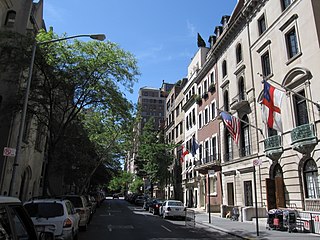
The Upper East Side, sometimes abbreviated UES, is a neighborhood in the borough of Manhattan in New York City, bounded approximately by 96th Street to the north, the East River to the east, 59th Street to the south, and Central Park and Fifth Avenue to the west. The area incorporates several smaller neighborhoods, including Lenox Hill, Carnegie Hill, and Yorkville. Once known as the Silk Stocking District, it has long been the most affluent neighborhood in New York City.

Fifth Avenue is a major and prominent thoroughfare in the borough of Manhattan in New York City. The avenue stretches downtown (southward) from West 143rd Street in Harlem to Washington Square Park in Greenwich Village. Fifth Avenue in Midtown Manhattan is the most expensive shopping street in the world.
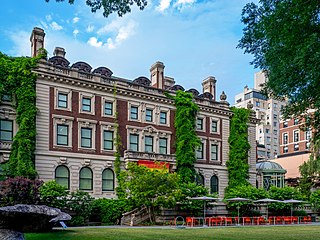
Carnegie Hill is a neighborhood within the Upper East Side, in the borough of Manhattan in New York City. Its boundaries are 86th Street on the south, Fifth Avenue on the west, with a northern boundary at 98th Street that continues just past Park Avenue and turns south to 96th Street and proceeds east up to, but not including, Third Avenue. The neighborhood is part of Manhattan Community District 8.

Manhattan Valley is a neighborhood in the northern part of the Upper West Side of Manhattan in New York City. It is bounded by West 110th Street to the north, Central Park West to the east, West 96th Street to the south, and Broadway to the west.
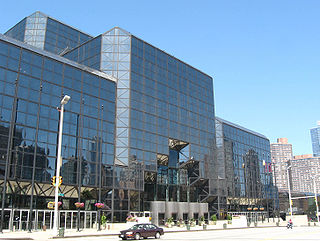
Eleventh Avenue is a north–south thoroughfare on the far West Side of the borough of Manhattan in New York City, located near the Hudson River. Eleventh Avenue originates in the Meatpacking District in the Greenwich Village and West Village neighborhoods at Gansevoort Street, where Eleventh Avenue, Tenth Avenue, and West Street intersect. It is considered part of the West Side Highway between 22nd and Gansevoort Streets.

86th Street is a major two-way street in the Upper East Side and Upper West Side of the New York City borough of Manhattan. It runs in two major sections: between East End and Fifth Avenue on the Upper East Side, and between Central Park West and Riverside Drive on the Upper West Side. The western segment feeds into the 86th Street transverse across Central Park, which connects to East 84th and 85th Streets on the eastern side.

St. Michael's Church is a historic Episcopal church at 225 West 99th Street and Amsterdam Avenue on Manhattan's Upper West Side in New York City. The parish was founded on the present site in January 1807, at that time in the rural Bloomingdale District. The present limestone Romanesque building, the third on the site, was built in 1890–91 to designs by Robert W. Gibson and added to the National Register of Historic Places in 1996.
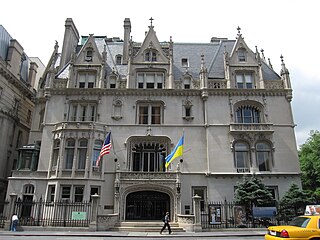
79th Street is a major two-way street on the Upper East Side and Upper West Side of the New York City borough of Manhattan. It runs in two major sections: between East End and Fifth Avenues on the Upper East Side, and between Columbus Avenue and Henry Hudson Parkway on the Upper West Side. The two segments are connected by the 79th Street transverse across Central Park, as well as one block of 81st Street.

89th Street is a one-way street running westbound from the East River to Riverside Drive, overlooking the Hudson River, in the New York City borough of Manhattan. The street is interrupted by Central Park. It runs through the Upper West Side, Carnegie Hill and Yorkville neighborhoods.
74th Street is an east–west street carrying pedestrian traffic and eastbound automotive/bicycle traffic in the New York City borough of Manhattan. It runs through the Upper East Side neighborhood, and the Upper West Side neighborhood, on both sides of Central Park.
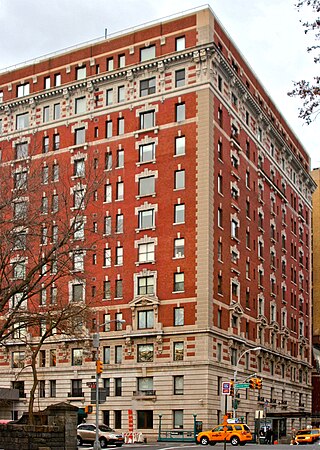
257 Central Park West is a co-op apartment building on the southwest corner of 86th Street and Central Park West in the Upper West Side of Manhattan in New York City. It was designed by the firm of Mulliken and Moeller and built by Gotham Building & Construction between 1905 and 1906.

Rossleigh Court, constructed between 1906 and 1907, currently is a rental apartment building located on the northwest corner of 85th Street and Central Park West in the Upper West Side of Manhattan in New York City.
Harry B. Mulliken was an early twentieth-century American architect and developer who built many of his works in New York City. Mulliken's apartment and hotel buildings are remarkable for their Beaux-Arts-style and broad use of architectural terra cotta set around flat, and often red, brick.
Edgar Joachim Moeller was an early twentieth-century American architect who partnered with Harry Mulliken to build several apartment hotels in New York City. The partnership's Beaux-Arts style is distinguishable and makes a similarly broad use of architectural terra cotta set around flat brick.

The Yorkville Bank Building is a structure at 201–203 East 85th Street, 1511–1515 Third Avenue on the Upper East Side of Manhattan in New York City. Designed by Robert Maynicke in the Renaissance Revival style, it was built for the Yorkville Bank in 1905 and was designated a landmark by the New York City Landmarks Preservation Commission in 2012.

The 86th Street Crosstown Line is a bus line in Manhattan, New York City, running mostly along 86th Street on the Upper West and Upper East Sides of Manhattan. Originally a streetcar line, it now comprises the M86 Select Bus Service bus line.

The 72nd Street station is an abandoned station located in the Park Avenue Tunnel used by Metro-North Railroad. The station has two side platforms and is located in between 72nd Street and 73rd Street underneath Park Avenue on the Upper East Side of Manhattan. The station was built by the New York Central & Hudson River Railroad as part of an agreement with New York City.

The 86th Street station is an abandoned station located in the Park Avenue Tunnel used by Metro-North Railroad. The station was built by the New York Central & Hudson River Railroad as part of an agreement with New York City. The station was built during the late 19th century. It was located at Park Avenue and 86th Street on the Upper East Side of Manhattan.


























